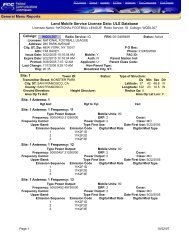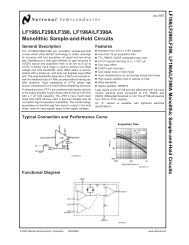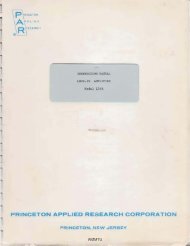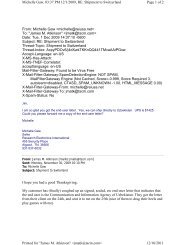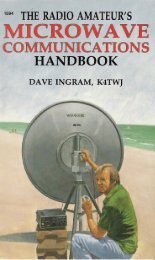A License Plate Recognition and Speed Detection System - Index of
A License Plate Recognition and Speed Detection System - Index of
A License Plate Recognition and Speed Detection System - Index of
You also want an ePaper? Increase the reach of your titles
YUMPU automatically turns print PDFs into web optimized ePapers that Google loves.
Federal Highway Administration <strong>and</strong> the National Highway Traffic Safety Administration have<br />
indicated their support for automated enforcement systems. Numerous states (Arizona,<br />
California, Colorado, Delaware, Hawaii, Illinois, Maryl<strong>and</strong>, New York <strong>and</strong> Virginia) have<br />
enacted statutes allowing the use <strong>of</strong> these automated systems to enforce traffic laws (Ref21).<br />
Connecticut statute (C.G.S. Title 14, Chapter 248, § 14-219c, Vehicle Highway Use), does not<br />
specifically mention photo radar or red light cameras, but the statute’s phrase “any other speed<br />
monitoring device approved by the Commissioner <strong>of</strong> Public Safety” could allow for their use. In<br />
the 2005 legislative session, House Bill 5744 (Ref. 31) attempted to introduce devices that are<br />
“designed to automatically record the image <strong>of</strong> the license plate <strong>of</strong> a motor vehicle that is<br />
entering an intersection in violation <strong>of</strong> a traffic control signal”. However, the bill was never<br />
signed into law. In the January 2007 session, raised bill #1443 was introduced in the State Senate<br />
where it has been referred to the Joint Committee on Judiciary; it has not left the Committee. In<br />
November 2007, Connecticut Governor Jodi Rell proposed installing automated traffic<br />
enforcement devices along a stretch <strong>of</strong> Interstate-95 in East Lyme where I-95, I-395, <strong>and</strong> Route 1<br />
intersect. This proposal is being reviewed by the Department <strong>of</strong> Public Safety.<br />
The National Highway Safety Commission has set 65/55 mph as the speed limit on much<br />
<strong>of</strong> the Federal Interstate Highway system, with lower limits set for densely populated areas. It is<br />
the responsibility <strong>of</strong> the individual states to establish appropriate speed limits for roadways that<br />
are not part <strong>of</strong> the Interstate system. For example, Connecticut General Statute Title 14, Chapter<br />
249, Part 1, Section 14-309, assigns the responsibility for determining safe speed limits to State<br />
Highway Traffic Commission.<br />
In most states motor vehicle violations are considered warrant-less misdemeanor<br />
violations <strong>and</strong> in general they fall under common law practice (Ref. 28). According to common<br />
76





